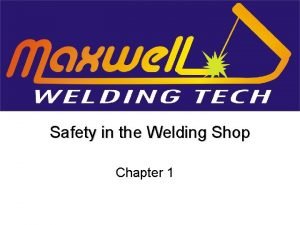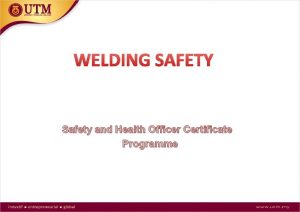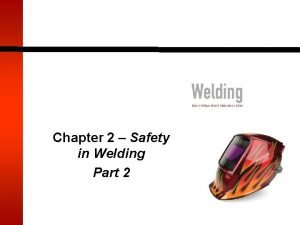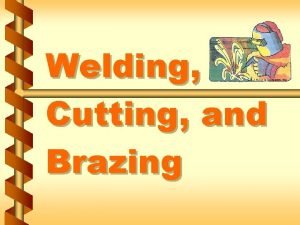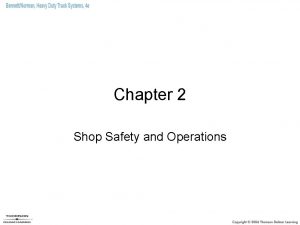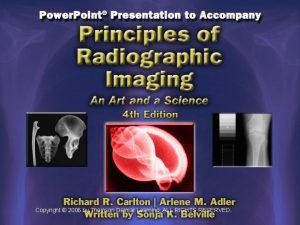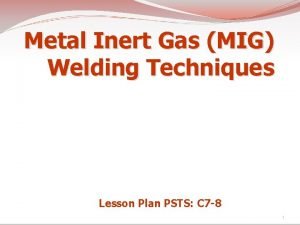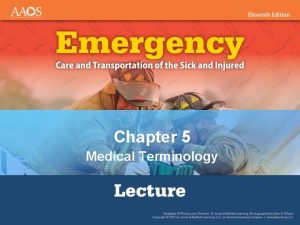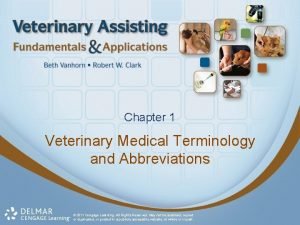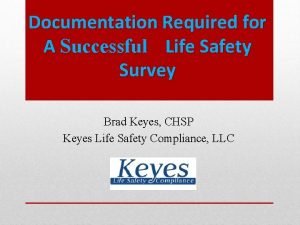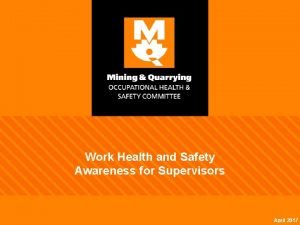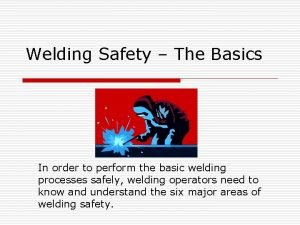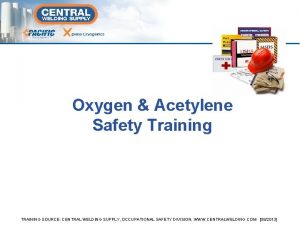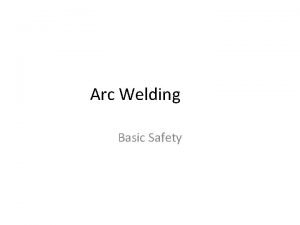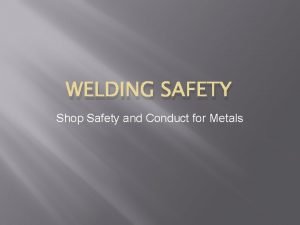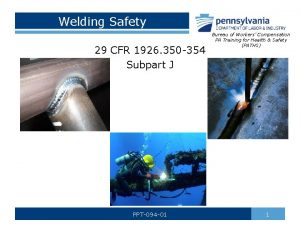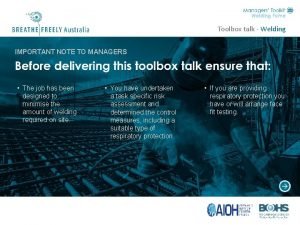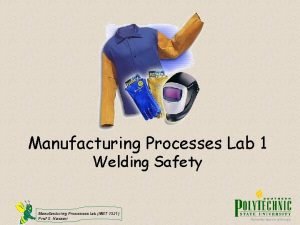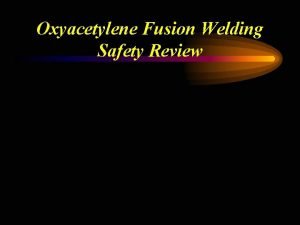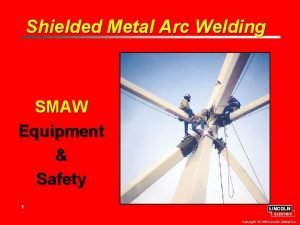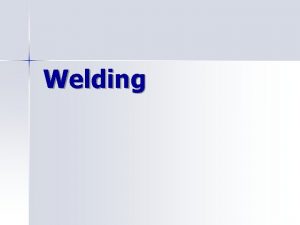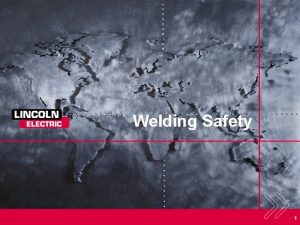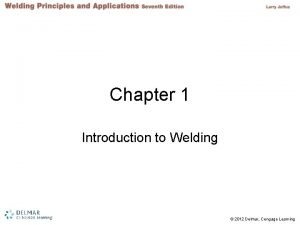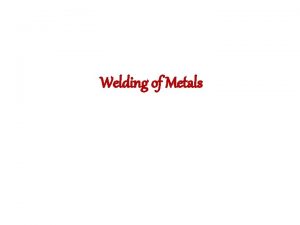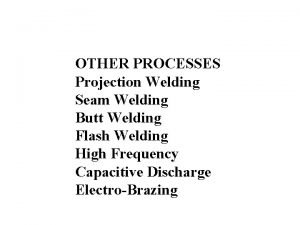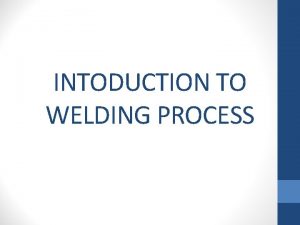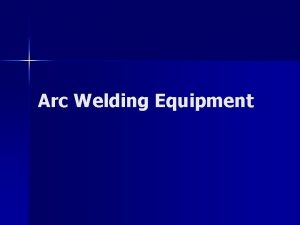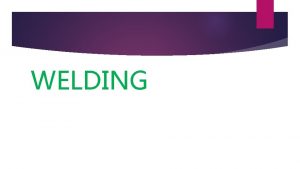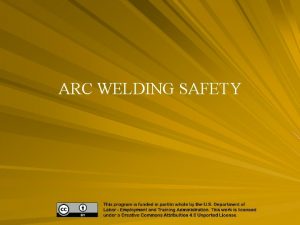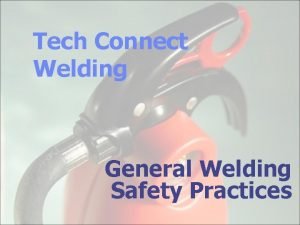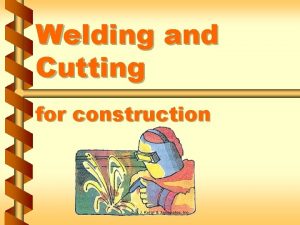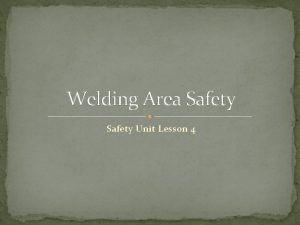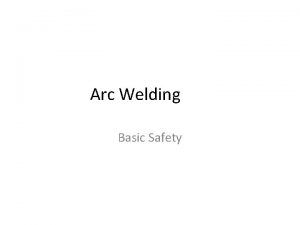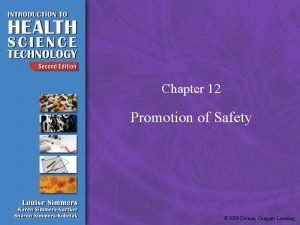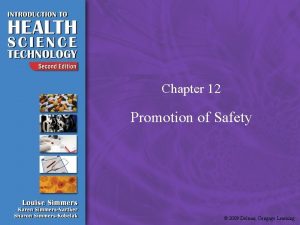Chapter 2 Safety in Welding 2012 Delmar Cengage






















































- Slides: 54

Chapter 2 Safety in Welding 2012 Delmar, Cengage. Learning ©© 2012

Objectives • Describe three classifications of burns and the emergency steps that should be taken to treat each of them • Describe the dangers all three types of light pose to welding and how to protect yourself and others from these dangers • Explain how to avoid eye and ear injuries • Use a chart to select the correct eye and face protective devices for working and welding in a shop 2012 Delmar, Cengage. Learning ©© 2012

Objectives (cont'd. ) • List the safety points that should be covered in a training program for respiratory protection • Describe the various types of respiratory protection equipment that are available • Tell how to avoid dangerous fumes and gases by providing ventilation to the welding area • Explain the purpose of material safety data sheets (MSDSs) and where they can be found • Discuss the benefits of recycling waste material 2012 Delmar, Cengage. Learning ©© 2012

Objectives (cont'd. ) • Describe what type of general work clothing should be worn in a welding shop • Describe special protective clothing worn by welders to protect the hands, arms, body, waist, legs, and feet • Describe the proper way to handle, secure, and store cylinders • Discuss how to protect against the danger of fire when welding 2012 Delmar, Cengage. Learning ©© 2012

Objectives (cont'd. ) • Explain why planned maintenance of tools and equipment is important • Describe the most commonly used hand power tools used by a welder • Explain good electrical safety practices and list rules for extension cords and portable power tools • Discuss the types of metal cutting machines • Describe proper ways to safely lift heavy welded assemblies • List the rules for ladder safety 2012 Delmar, Cengage. Learning ©© 2012

Introduction • No substitute for caution and common sense – Each person must take personal responsibility • Their own safety and safety of others on the job • Welding is a very large and diverse industry – This chapter concentrates on light welding fabrication • A number of potential safety hazards • Learning to work safely – As important as learning to be a skilled welding fabrication worker 2012 Delmar, Cengage. Learning ©© 2012

Burn Classification • Burns – One of the most common and painful injuries – Caused by ultraviolet light rays or contact with hot welding torches – Chance of infection is high • All burns must receive proper medical treatment – Divided into three classifications • First-degree, second-degree, and third-degree 2012 Delmar, Cengage. Learning ©© 2012

First-Degree Burns • Characteristics – Surface of the skin is reddish, tender, and painful – No broken skin • Treatment – Put burned area under cold water or apply a cold compress – Cover the area with sterile bandages – Never apply butter or grease 2012 Delmar, Cengage. Learning ©© 2012

FIGURE 2 -1 First-degree burn—only the skin surface (epidermis) is affected. © Cengage Learning 2012 Delmar, Cengage. Learning ©© 2012

Second-Degree Burns • Characteristics – Surface of the skin is severely damaged – Blisters and possible breaks in the skin • Treatment – Put the area under cold water or use cold water compresses – Pat area with a dry lint-free towel and cover with a sterile bandage – Seek medical attention 2012 Delmar, Cengage. Learning ©© 2012

FIGURE 2 -2 Second-degree burn—the epidermal layer is damaged, forming blisters or shallow breaks. © Cengage Learning 2012 Delmar, Cengage. Learning ©© 2012

Third-Degree Burns • Characteristics – Surface of skin appears white or charred • Treatment – Never remove any clothing – Never use ice water or ice, ointments, sprays, etc. – If victim is on fire: smother fire with a blanket, rug, or jacket – Cover with a thick, nonfluffy, sterile dressing – Call for an ambulance 2012 Delmar, Cengage. Learning ©© 2012

FIGURE 2 -3 Third-degree burn—the epidermis, and the subcutaneous layers of tissue are destroyed. © Cengage Learning 2012 Delmar, Cengage. Learning ©© 2012

Burns Caused by Light • Some types of light can cause burns – Ultraviolet – Infrared – Visible • Arc welding produces all three types of light – Gas welding produces visible and infrared light only • Light from the welding process – Can be reflected from walls, ceilings, floors, etc. 2012 Delmar, Cengage. Learning ©© 2012

Ultraviolet Light • Ultraviolet light waves – Most dangerous – Causes first- and second-degree burns to eyes or exposed skin – Closer welder is to the arc and higher the current: quicker a burn may occur – Welder's eyes can receive a flash burn in seconds 2012 Delmar, Cengage. Learning ©© 2012

Infrared Light • Light wave is felt as heat – A person will immediately feel this type of light – Burns can be easily avoided – Protective action should be taken to cover yourself 2012 Delmar, Cengage. Learning ©© 2012

Visible Light • Light that we see – Produced in varying quantities and colors – May cause temporary night blindness – Too little visible light may cause eye strain – Visible light is not hazardous 2012 Delmar, Cengage. Learning ©© 2012

Face, Eye, and Ear Protection • Eye protection – Must be worn in the shop at all times • • Safety glasses with side shields Goggles Full face shield Flash glasses • Welding light damage – Often occurs without warning 2012 Delmar, Cengage. Learning ©© 2012

Welding Helmets • Even with quality welding helmets, the welder must check for potential problems – Undetectable leaks of ultraviolet light can cause a welder's eyes to itch or feel sore • Ensure lens gasket is installed correctly • Tape can be used as a temporary repair 2012 Delmar, Cengage. Learning ©© 2012

Safety Glasses • Safety glasses with side shields – Adequate for general use – Not suitable for heavy grinding, chipping, or overhead work – Must be worn under an arc welding helmet at all times 2012 Delmar, Cengage. Learning ©© 2012

Ear Protection • Welding environment can be very noisy – Hot sparks can drop into an open ear and cause severe burns – Several forms of protection • Earmuffs cover the outer ear completely • Earplugs fit into the ear canal 2012 Delmar, Cengage. Learning ©© 2012

Respiratory Protection • Welding and cutting produce harmful by-products – Respirators protect against welding by-products • Welders are responsible for following the shop's written respiratory protection policy • Training should include: – Proper respirator use – Maintenance schedules and respirator selection – Procedures for testing the proper fitting and use – Regular program evaluation 2012 Delmar, Cengage. Learning ©© 2012

Equipment • Respiratory protection equipment – Air-purifying respirators – Atmosphere-supplying respirators – Demand respirators – Positive pressure respirators – Powered air-purifying respirators – Self-contained breathing apparatuses – Supplied-air respirators 2012 Delmar, Cengage. Learning ©© 2012

Fume Sources • Materials can cause respiratory problems – Paints, coating, or plating on metals • Before welding or cutting any painted metal: surface must be cleaned • Marine industry – Still uses lead-based paints • Exposure to cadmium fumes – Can cause lung and kidney damage • Best way to avoid problems – Adequate ventilation 2012 Delmar, Cengage. Learning ©© 2012

Vapor Sources • Potentially dangerous gases – Also can be present in a welding shop • Proper ventilation or respirators are necessary when welding in confined spaces • Ozone gas – Produced by ultraviolet radiation – Irritates mucous membranes • Collection of fumes and gases can go unnoticed – Concentrated fumes can cause a fire or explosion 2012 Delmar, Cengage. Learning ©© 2012

Ventilation • Welding area should be well ventilated – Natural ventilation is best – Forced ventilation may be required – Large enough areas may not require forced ventilation 2012 Delmar, Cengage. Learning ©© 2012

FIGURE 2 -15 A room with a ceiling 16 ft (4. 9 m) high may not require forced ventilation for one welder. © Cengage Learning 2012 Delmar, Cengage. Learning ©© 2012

Forced Ventilation • Small shops or shops with many welders require forced ventilation – Can be general or localized – Fixed or flexible exhaust pickups – Required when welding on metals that give off dangerous fumes 2012 Delmar, Cengage. Learning ©© 2012

Material Safety Data Sheets (MSDSs) • Provide details of possible hazards – Must be provided to anyone using the product or working in the area where products are in use – Often posted on a bulletin board or put in a convenient place where products are used – If injured while using a product: take material's MSDS when you seek treatment 2012 Delmar, Cengage. Learning ©© 2012

General Work Clothing • Guidelines – Shirts must be long-sleeved – Pants must be long enough to cover the tops of the boots and must be without cuffs – Boots must have high tops – Caps should be thick – Clothing must be free of frayed edges or holes • Some clothes have pockets – Not safe to carry a butane lighter or matches while welding 2012 Delmar, Cengage. Learning ©© 2012

Special Protective Clothing • Extra protection is needed for each person who is in direct contact with hot materials – Hand protection – Body protection – Waist and lap protection – Arm protection – Leg and foot protection 2012 Delmar, Cengage. Learning ©© 2012

Handling and Storing Cylinders • Considerations – Store oxygen and fuel gas cylinders separately – Store inert gas cylinders separately or with oxygen cylinders – Secure gas cylinders – Cylinder storage areas must be located away from halls, stairwells, and exits – Cylinders with a valve protection cap must have the cap in place 2012 Delmar, Cengage. Learning ©© 2012

General Precautions • Any cylinders with a defect must be identified – Leak cannot be stopped • Move cylinder to a vacant lot • Slowly release pressure • Post a warning sign • Acetylene cylinders – Must be upright for four hours before use • Otherwise may draw acetone from the cylinder 2012 Delmar, Cengage. Learning ©© 2012

FIGURE 2 -25 Move a leaking fuel gas cylinder out of the building or any work area. The pressure should be slowly released after a warning is posted of the danger. © Cengage Learning 2012 Delmar, Cengage. Learning ©© 2012

Fire Protection • Fire is a constant danger – Highly combustible materials should by 35 feet away from any welding – Fire watch can be provided by any person who knows how to sound an alarm – Fire extinguisher must be the type required to put out a fire for the type of combustible material 2012 Delmar, Cengage. Learning ©© 2012

Fire Extinguishers • Four types – Type A: combustible solids – Type B: combustible liquids – Type C: electrical fires – Type D: combustible metals • Location – Appropriate type should be located near types of combustible materials it is used for 2012 Delmar, Cengage. Learning ©© 2012

Fire Extinguishers (cont’d. ) • Use – Extinguishers cool the fire and remove oxygen – Use foam, carbon dioxide, a pump tank, or dry chemicals • CO 2 extinguisher: direct discharge as close to the fire as possible • Dry chemical extinguisher: direct toward the base of the flames 2012 Delmar, Cengage. Learning ©© 2012

Equipment Maintenance • Planned maintenance (PM) – Detects problems • Hoses must be used for the gas or liquids for which they were designed – Green hoses are used only for oxygen – Red hoses are used only for fuel gases • Never use oil grease, or other pipe-fitting compounds on joints – Any leaking or bad joints must be repaired 2012 Delmar, Cengage. Learning ©© 2012

Work Area • Considerations – Work area: should be picked up and swept clean – Arc welding areas: painted with a flat dark color – Portable screens: used if welding outside the welding booth – Piece of hot material is left unattended: write hot on it before leaving 2012 Delmar, Cengage. Learning ©© 2012

Hand Tools • Used for assembly and disassembly of parts – Adjustable wrench is the most popular – Fewer points a box end wrench or socket has: the stronger it is – Mushroomed heads of chisels, punches, and the faces of hammers should be ground off – Always use the correct tool for the job 2012 Delmar, Cengage. Learning ©© 2012

Hand Tool Safety • Considerations – Hand tools should be treated properly and not abused – Keep hand tools clean – Make sure that hand tools are sharp – Protect cutting edges when carrying – Keep hammer handles secure and safe – When swinging a hammer, be absolutely certain that no one is within range 2012 Delmar, Cengage. Learning ©© 2012

Electrical Safety • Injuries and death can be caused by electrical shock – Resistance is lowered in the presence of water or moisture – Electrically powered machines must be grounded – Electrical connections must be tight – Do not allow metal parts of electrodes or electrode holders to touch skin or wet coverings on bodies – Welding circuits must be turned off when the work station is left unattended 2012 Delmar, Cengage. Learning ©© 2012

Electrical Safety Systems • Two safe systems for electrical power tools – External grounding • A wire runs from the housing to a third prong • Third prong plug fits into grounded outlet – Double-insulation • Extra layer of insulation • Eliminates need for three-pronged grounded outlet 2012 Delmar, Cengage. Learning ©© 2012

Voltage Warnings • Voltage – Same as specified on the tool • Voltage greater than the tool – Can lead to injury and tool damage • Voltage lower than the tool – Can damage the motor • Amperes (Amps) – Measures electrical current 2012 Delmar, Cengage. Learning ©© 2012

Extension Cords • Use only three-wire, grounded extension cords – Safety tips • • Connect cord of tool into extension cord first Unplug extension cord from receptacle first Extension cords should be long enough Cord should not come in contact with sharp objects and must be positioned appropriately • Check for loose or exposed wires and unusual heating • Use a knot to prevent accidental separation • Clean before storing 2012 Delmar, Cengage. Learning ©© 2012

Safety Rules for Portable Electric Tools • Safety precautions – Know the tool and ground when needed – Do not expose to water – Keep the area well lighted – Do not use near propane or flammable vapors – Do not force a cutting tool to cut faster – Use the right tool for the job – Wear eye and face protection – Secure your work with clamps – Maintain power tools 2012 Delmar, Cengage. Learning ©© 2012

Safety Rules for Portable Electric Tools (cont’d. ) – Disconnect from power source when not in use – Check to see keys or wrenches are removed – Avoid accidental starting – Be sure accessories and bits are attached securely – Do not use tools with cracked or damaged housings – Give your full and undivided attention – Never use a power tool with its safeties or guards removed or inoperable 2012 Delmar, Cengage. Learning ©© 2012

Grinders • Grinding using a pedestal or portable grinder is required to do many welding jobs – Before a grinding stone is put on a machine, it should be tested for cracks – Each grinding stone is made for grinding specific types of metal – Stone should not be used when worn down – Gloves should never be worn when grinding 2012 Delmar, Cengage. Learning ©© 2012

Drills • Considerations – Secure workpiece before drilling – Center-punch workpiece before drilling – Hold drill perpendicular to the face of the work • Except when drilling a hole at an angle – Use just steady, even pressure – Drill becomes jammed in the hole • Release trigger immediately • Remove drill bit • Determine cause 2012 Delmar, Cengage. Learning ©© 2012

Metal Cutting Machines • Many types – Shears and punches • Used in fabrication of metal for welding – Cut-off machines • Use abrasive wheels or special saw blades – Band saws • Vertical or horizontal • Some can be used in either position 2012 Delmar, Cengage. Learning ©© 2012

Material Handling • Improper work habits – Can cause serious personal injury and damage to equipment and materials • Lifting – Weight of the object should be evenly distributed between both hands • Hoists or cranes – Capacity should be checked before lifting a heavy load 2012 Delmar, Cengage. Learning ©© 2012

Ladder Safety • Improper use of ladders is often a factor in falls – All ladder use poses potential hazards – Keep the area around the ladder clear • Step ladders and straight ladders – Used extensively in welding shops 2012 Delmar, Cengage. Learning ©© 2012

Ladder Safety (cont’d. ) • Ladders can become damaged over time – Look for loose or damaged parts – Check that all hardware is tight – Check wooden ladders for cracks – Never use a defective ladder – Ladder cannot be repaired: replace it – Read the entire ladder manufacturer's list of safety rules for ladder use 2012 Delmar, Cengage. Learning ©© 2012

Summary • Safety is of the utmost importance – Safety officer ensures welders comply with safety rules – Wear proper clothing, shoes, and protection – Have established procedures in case of accidents – Check equipment periodically – Further information is available in Safety for Welders, by Larry E. Jeffus 2012 Delmar, Cengage. Learning ©© 2012
 Delmar cengage learning medical terminology
Delmar cengage learning medical terminology 2009 delmar cengage learning
2009 delmar cengage learning Introduction to medical terminology chapter 1 answer key
Introduction to medical terminology chapter 1 answer key 2009 delmar cengage learning
2009 delmar cengage learning 2009 delmar cengage learning
2009 delmar cengage learning Chapter 13 medical math assignment sheet
Chapter 13 medical math assignment sheet Chapter 10 cultural diversity
Chapter 10 cultural diversity Delmar cengage learning instructor resources
Delmar cengage learning instructor resources 2012 cengage learning
2012 cengage learning Welding shop safety vocabulary
Welding shop safety vocabulary Smaw safety
Smaw safety Welding safety quiz
Welding safety quiz Chapter 2 welding safety
Chapter 2 welding safety Welding safety program
Welding safety program Chapter 2 shop safety
Chapter 2 shop safety Delmar isotonic
Delmar isotonic Delmar tsi
Delmar tsi Delmar custom broker
Delmar custom broker Thomson delmar learning
Thomson delmar learning Delmar larsen
Delmar larsen Brazing weld symbol
Brazing weld symbol Mig welding patterns
Mig welding patterns The human respiratory system chapter 7 handout
The human respiratory system chapter 7 handout Cengage chapter 7
Cengage chapter 7 Chapter 13 accounting
Chapter 13 accounting Cengage chapter 7
Cengage chapter 7 Medical terminology chapter 5 learning exercises answers
Medical terminology chapter 5 learning exercises answers Chapter 8 the digestive system labeling exercises
Chapter 8 the digestive system labeling exercises Knowledge of medical terminology
Knowledge of medical terminology Chapter 4 the muscular system labeling exercises
Chapter 4 the muscular system labeling exercises Prescription terms
Prescription terms National patient safety goals 2012
National patient safety goals 2012 2012 life safety code documentation checklist
2012 life safety code documentation checklist Work health and safety act 2012 sa
Work health and safety act 2012 sa Welding safety precautions
Welding safety precautions Welding safety precautions
Welding safety precautions Welding safety precautions
Welding safety precautions Welding shop safety
Welding shop safety Welding safety ppt
Welding safety ppt Welding safety toolbox talk
Welding safety toolbox talk Welding safety
Welding safety Welding and cutting safety toolbox talk
Welding and cutting safety toolbox talk Oxy acetylene safety rules
Oxy acetylene safety rules Smaw tools
Smaw tools Cengage differential equations
Cengage differential equations Century 21 bank
Century 21 bank Separation of variables differential equations
Separation of variables differential equations Cengage learning heart diagram
Cengage learning heart diagram Cengage
Cengage Cengage
Cengage Cengage
Cengage South-western cengage learning
South-western cengage learning Cengage
Cengage Cengage
Cengage Artist
Artist









